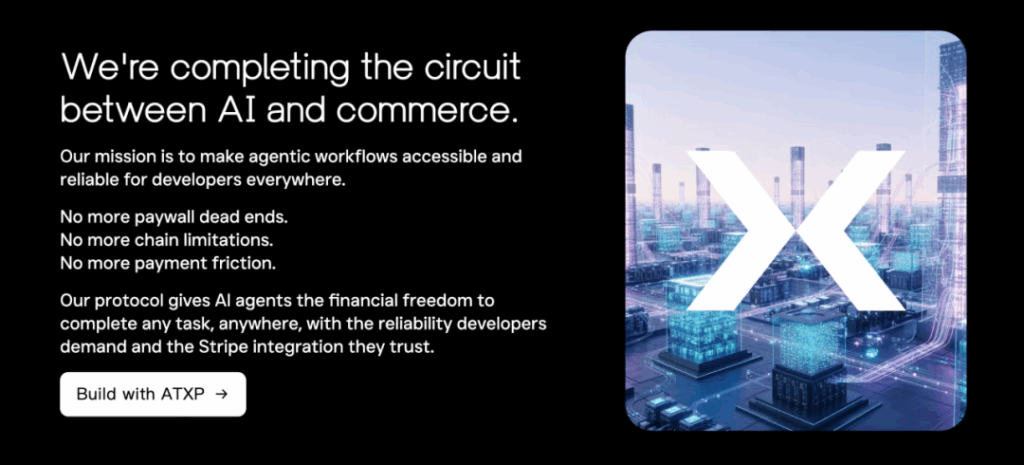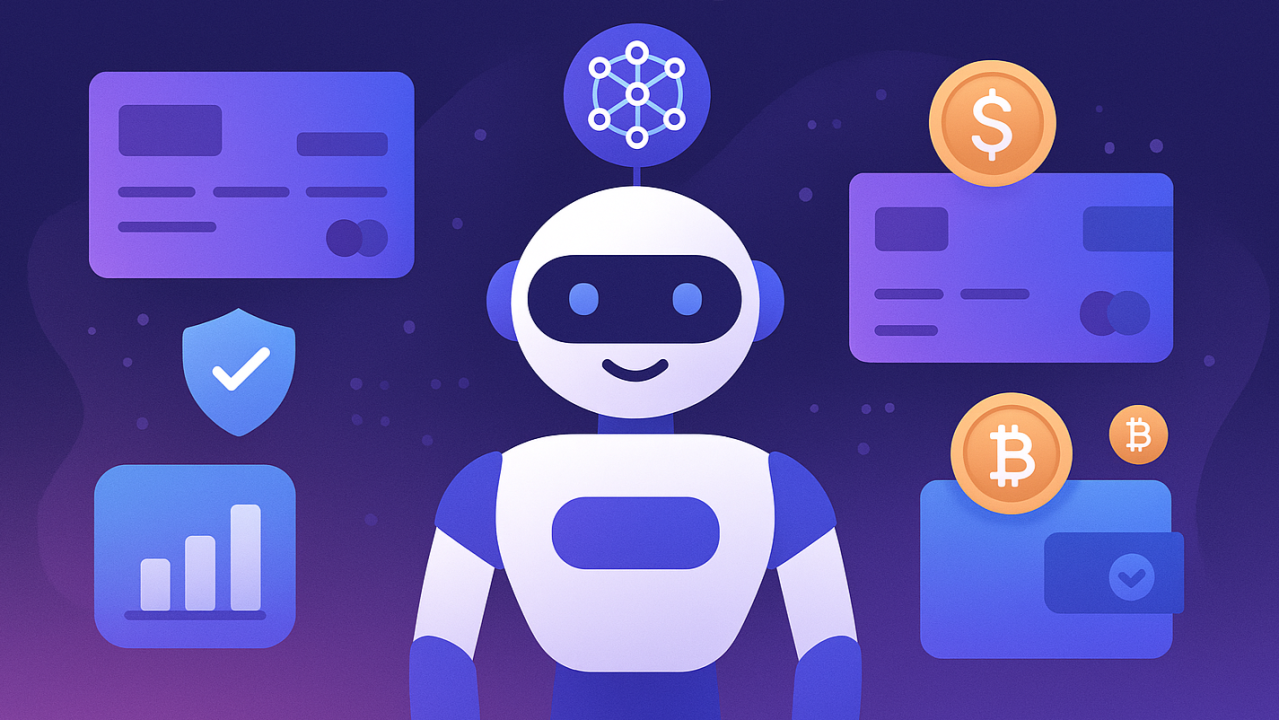The early web was a mess. Pages sat in isolation, unable to link to each other, information trapped in silos. Then Tim Berners-Lee introduced HTTP, and suddenly the internet made sense.
AI agents are stuck in a similar moment right now, but their problem isn’t communication—it’s money.
Two former Stripe executives believe they’ve found the answer. Louis Amira and David Noël-Romas just raised $19.2 million for Circuit & Chisel, a startup building ATXP—what they’re calling “HTTP for AI agent payments.” If they’re right, we’re watching the foundation being laid for a fundamentally different kind of economy, one where AI agents transact autonomously, paying for services in real-time without anyone signing off on each purchase.
The AI Agent Payment Bottleneck Holding Back Autonomous Commerce
AI agents can do remarkable things now. They browse the web, analyze spreadsheets, draft memos, write code. But ask them to pay for something? They’re helpless.
It’s not a capability problem. It’s infrastructure. Our payment systems assume human users: identity verification, monthly subscriptions, transaction fees built around purchases measured in dollars. None of this works for AI agent payments.
The economics are shifting fast. On some websites, bots now visit pages 60,000 times more often than they recommend those pages to humans. That’s not a curiosity—it’s a structural change that breaks how the internet makes money. Advertising dies when your audience is AI. Subscriptions make no sense when an agent needs something once, not indefinitely.
“As AI agents increasingly navigate the web and transact on our behalf, they require an entirely new monetization infrastructure,” says Emily Man, partner at Primary Venture Partners, one of Circuit & Chisel’s lead investors. “ATXP enables instant, nested, delegated, and ultra-low-cost micropayments between AI agents—something that traditional payment rails are structurally incapable of supporting.”
We don’t need better payment processors. We need different ones entirely.
Why AI Micropayments Are Essential for Agent Commerce
Look at actual use cases and the mismatch becomes obvious. An AI agent researching a topic needs one paywalled article from Fortune—not a subscription, just access to that single piece for maybe five cents. Or it queries a specialized database once, runs a calculation through a paid API, taps a niche tool for one specific task.
Credit card networks can’t handle this. When fees are 30 cents plus 2.9%, a five-cent payment is economically absurd. You’re using a cargo ship to deliver a postcard.
This infrastructure gap is why AI agents haven’t had their App Store moment. ATXP is designed to close it.
What Makes ATXP Different: AI Payment Protocol Architecture
Circuit & Chisel didn’t build a payment processor. They built a protocol for autonomous commerce.
Start with nested transactions. An AI agent can break complex tasks into subtasks, each with its own billing. Think of a general contractor hiring subs—except it happens automatically, instantly, at machine speed.
Then there’s delegated decision-making. An agent operates within spending limits, but when it hits something outside those parameters, it escalates without grinding to a halt. You get autonomy with oversight built in.

Most critically, ATXP is open. No single company controls it. This matters enormously. Closed standards might help their creators short-term, but they choke innovation. Open protocols—HTTP, TCP/IP, SMTP—become universal precisely because anyone can build on them.
The protocol integrates with the Model Context Protocol (MCP), which helps AI agents discover and use tools. MCP handles discovery; ATXP handles payment. Together: discover a service, evaluate it, pay for access, use it. A complete loop with no human in the middle.
Circuit & Chisel also built in flexibility. ATXP supports multiple payment methods and blockchains. Given how fast this space moves, that could prove essential.

The Circuit & Chisel Advantage: Building on Stripe DNA
The founders bring unusual credentials. Louis Amira was Stripe’s first external crypto hire, eventually leading crypto and AI partnerships. David Noël-Romas ran crypto engineering, building much of Stripe’s core infrastructure. Between them: deep knowledge of traditional payments, cryptocurrency rails, and AI developer tools. That combination is rare.
Their investor list reflects it. Primary Venture Partners and ParaFi Capital co-led the $19.2 million round. Stripe joined, along with Coinbase Ventures, Solana Ventures, Samsung Next, and Polygon Labs. Angels include Solana co-founders Anatoly Yakovenko and Raj Gokal.
Notice something? These companies are often competitors. Their joint investment signals recognition that the AI agent economy needs foundational infrastructure—and no single player can build it alone.
Stripe’s involvement goes beyond capital. ATXP will support Tempo, Stripe’s blockchain for stablecoin payments, creating direct integration with one of the world’s most sophisticated payment systems. For infrastructure this fundamental, that backing matters.
Why Open Standards Win in the AI Agent Economy
The internet’s most successful protocols share a trait: they’re open, neutral, extensible. HTTP didn’t dominate because one company owned it. It dominated because anyone could use it, build on it, extend it.
Circuit & Chisel is making the same bet for AI payments. Competitors are emerging—Google partnered with Coinbase on an open-source payment protocol; Coinbase is developing its own x402 standard—but rather than fragmenting into warring camps, major tech companies seem to be converging around openness.
They’ve realized closed systems won’t work for something this fundamental. Stripe, Coinbase, Google—they’re collaborating more than competing.
Matthew Prince, Cloudflare’s co-founder and CEO, put it clearly: “At Cloudflare, we’re committed to building an open internet—and with the rise of AI and agents, that’s more important than ever. ATXP could be a key protocol to ensure agent-initiated commerce happens securely and reliably.”
That’s not just endorsing ATXP’s technology. It’s affirming the philosophy that powered the web’s first era.
Circuit & Chisel’s strategy reflects this: establish the protocol first, build applications later. The protocol itself might not generate massive revenue directly, but controlling infrastructure provides leverage. It’s the old “build the roads before the cars” playbook—which keeps working because it’s sound.
Unlocking the AI Micropayment Economy for Autonomous Agents
Maybe ATXP’s biggest promise is finally delivering the micropayment economy technologists have talked about for decades without ever building.
The concept is simple: pay tiny amounts for exactly what you consume. Read one article? A few cents. Query a database once? Pay for that query. It promises efficiency and fairness—value created equals value captured.
But micropayments have failed repeatedly. Chicken-and-egg: without infrastructure for frictionless small transactions, no one builds micropayment services. Without services, no one builds infrastructure. Add cultural barriers—consumers hate thinking about payments constantly—and you see why it never worked.
AI agents change everything. They create natural demand because their usage patterns don’t fit subscriptions. An agent might need hundreds of services, each used sporadically. Subscribing to all would be impossibly expensive; using none cripples capabilities. Micropayments solve this elegantly.
The technical pieces have also fallen into place. Stablecoin infrastructure enables fast, low-cost transactions without cryptocurrency’s volatility. Timing looks right to break the deadlock.
If Circuit & Chisel succeeds, expect an explosion of AI-specific services, similar to the app boom after the iPhone launched. When agents can autonomously discover, evaluate, and pay for services, their capabilities expand dramatically. New business models emerge for creators and developers who can monetize directly, without platforms taking a cut.
How AI Agent Payments Transform Developer Monetization
For developers, ATXP fundamentally changes how AI tools get monetized. Previously, the options were limited: integrate with major platforms and accept their terms, or build complex custom payment systems. With ATXP, the path simplifies: build a tool, register it on an MCP server, enable payments, let agents discover it.
Direct monetization should unleash innovation. When developers capture the value they create without intermediaries, they have stronger incentives to build specialized, high-quality tools. The AI developer ecosystem will likely mirror mobile apps—an explosion of niche services, each solving specific problems well.
New roles are already emerging: AI agent business strategists optimizing how agents evaluate and purchase services, micropayment specialists fine-tuning pricing for agent consumption, inter-agent collaboration designers architecting complex workflows.
Standards will rise too. AI agents can’t navigate vague documentation or tolerate broken APIs the way human developers sometimes muddle through. Services wanting agent traffic will need higher quality bars.
Circuit & Chisel’s SDK abstracts payment complexity, letting developers focus on functionality. Smart positioning—the easier integration becomes, the faster the ecosystem grows.
The Road Ahead: Autonomous AI Commerce
ATXP raises fascinating questions about AI autonomy. When agents gain payment capabilities, they acquire economic independence—not just technical skill, but the ability to make commercial decisions, evaluate trade-offs, develop strategies.
Picture a company’s AI agent conducting market research. It autonomously accesses proprietary databases, purchases industry reports, hires specialized agents for analysis—all within budget. Humans set goals and constraints; the agent executes. This is technically feasible now. ATXP makes it economically viable.
As agents transact extensively with each other, they’ll form complex economic networks—marketplaces of specialized services for analytics, content creation, decision support, countless other functions. These networks could develop their own dynamics, mirroring specialization in human economies.
ATXP’s nested transactions enable this. A “general contractor” agent decomposes a project, hiring specialists for each component. Those agents might subcontract further, creating multi-layered structures.
Questions multiply: Who’s responsible for an agent’s economic decisions? How do we ensure agents act in their owner’s interests? How do we prevent misuse? While answers aren’t simple, ATXP’s transparent, traceable payment records provide an accountability foundation that didn’t exist before.
The transformation extends beyond AI systems. When agents become primary economic decision-makers, entire industries adapt. Marketing teams learn to “sell” to AI. CRM evolves to track agent interactions. Companies compete to make their services discoverable and appealing to evaluation algorithms.
Building AI Payment Infrastructure for the Agent Economy
Circuit & Chisel is building infrastructure for a world that doesn’t quite exist yet—but is arriving fast. HTTP enabled the web’s explosive growth by solving a fundamental coordination problem. ATXP aims to solve the AI agent economy’s coordination problem around payments.
Timing looks right. AI agents are proliferating. Stablecoin infrastructure has matured. Major tech companies recognize the need for open standards. The chicken-and-egg problem that killed previous micropayment attempts might finally be solvable because AI agents create natural, massive demand.
The “build the roads first” strategy has proven effective throughout tech history. The protocol itself might not generate huge direct revenue, but as foundational infrastructure for a new economic paradigm, Circuit & Chisel occupies a uniquely strategic position.
Realizing this vision requires navigating significant technical, commercial, and regulatory challenges. But the convergence of AI capability, stablecoin maturity, and ecosystem recognition suggests we’re at a genuine inflection point.
The early internet needed HTTP to unlock its potential. The AI economy needs something similar for payments. ATXP might be it. And if Circuit & Chisel succeeds, we’re not just watching a new protocol launch—we’re watching the foundation being laid for an entirely different digital economic system, one where AI agents are full economic participants, not just tools executing commands.
The transformation is just beginning.

Leave a Reply